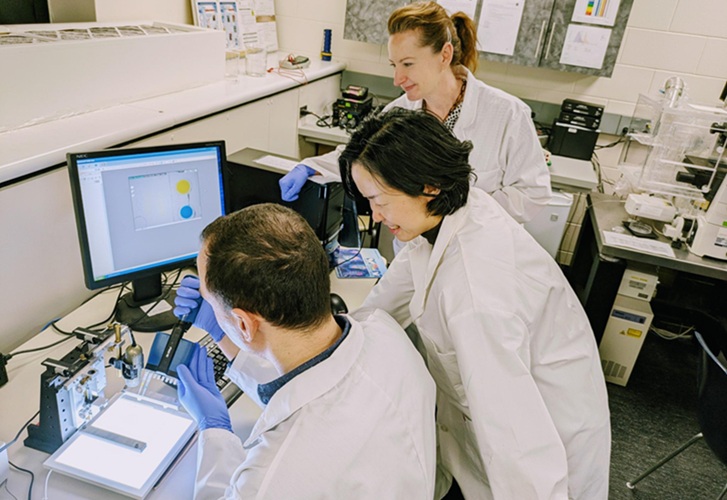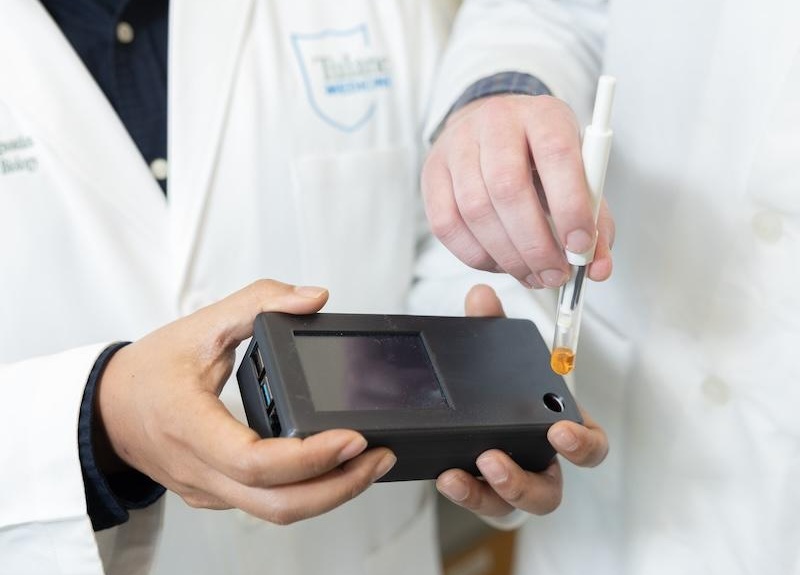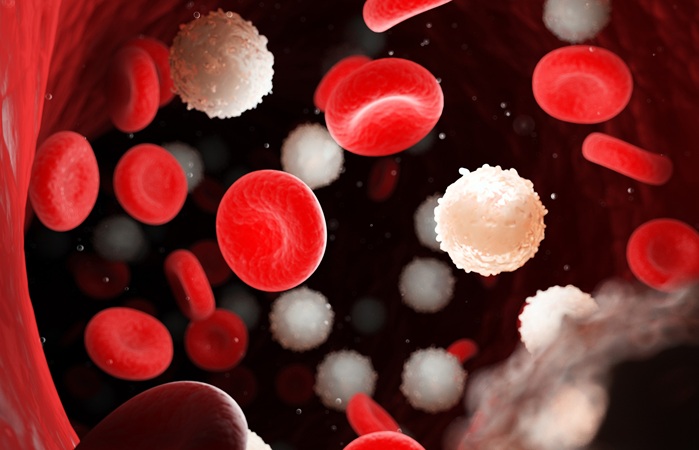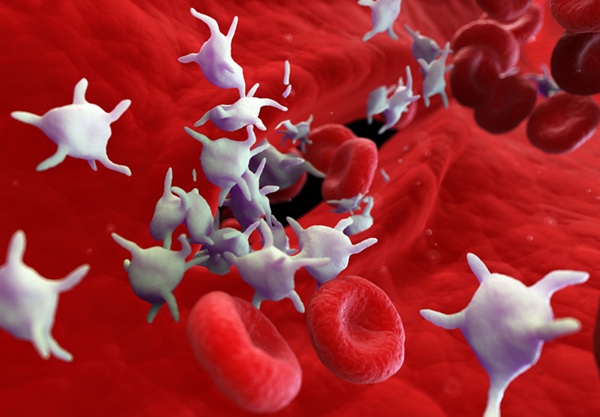Early Gene Changes Identified That Precede Blood Cancer
|
By LabMedica International staff writers Posted on 15 Dec 2014 |

Image: The HiSeq 2000 sequencing platform (Photo courtesy of Illumina).
DNA samples have been used to uncover early, precancerous genetic changes in the blood that are linked to increased chances of developing blood cancers such as leukemia, lymphoma or myelodysplastic syndrome.
The development of disease often involves dynamic processes that begin years or decades before the clinical onset and in many cases the process of pathogenesis goes undetected until after the patient has symptoms and presents with clinically apparent disease.
A large team of scientists led by those at Harvard Medical School (Boston, MA, USA) obtained blood samples for DNA sequencing from 12,380 Swedish persons whose mean age at time of sample collection was 55 years. The cohort included 6,245 controls, 4,970 persons with schizophrenia, and 1,165 persons with bipolar disorder. DNA was extracted directly from peripheral venous blood samples.
The initial sequencing was carried out using the genome analyzer GAII (Illumina; San Diego, CA, USA) instruments and the remaining specimens were sequenced using Illumina’s HiSeq 2000 and HiSeq 2500 instruments, with pair ended sequencing reads of 76 base pairs across all specimens. Sequencing was performed at the Broad Institute (Cambridge, MA, USA) and Harvard across the period of time from 2010 to 2013.
The team found that a subset, some, but not all, of mutations known to feature in blood cancers were present in individuals who were 10 times more likely to develop blood cancer later in life, compared with individuals who did not have these mutations. This cluster of pre-cancerous mutations, which was easily detected by DNA sequencing, is rarely found in the blood of people under the age of 40. It becomes more common with age and appears in more than 10% of people over the age of 70. Most of the mutations occurred in just three genes: DNA (cytosine-5)-methyltransferase 3A (DNMT3A), tet methylcytosine dioxygenase 2 (TET2) and, additional sex combs like transcriptional regulator 1 (ASXL1).
Steven A. McCarroll, PhD, an assistant professor of genetics and a senior author of the study said, “The results demonstrate a way to identify high-risk cohorts, people who are at much higher than average risk of progressing to cancer, which could be a population for clinical trials of future prevention strategies. The abundance of these mutated cells could also serve as a biomarker to test the effects of potential prevention therapies in clinical trials.” The study was published on November 26, 2014, in the New England Journal of Medicine (NEJM).
Related Links:
Harvard Medical School
Illumina
Broad Institute
The development of disease often involves dynamic processes that begin years or decades before the clinical onset and in many cases the process of pathogenesis goes undetected until after the patient has symptoms and presents with clinically apparent disease.
A large team of scientists led by those at Harvard Medical School (Boston, MA, USA) obtained blood samples for DNA sequencing from 12,380 Swedish persons whose mean age at time of sample collection was 55 years. The cohort included 6,245 controls, 4,970 persons with schizophrenia, and 1,165 persons with bipolar disorder. DNA was extracted directly from peripheral venous blood samples.
The initial sequencing was carried out using the genome analyzer GAII (Illumina; San Diego, CA, USA) instruments and the remaining specimens were sequenced using Illumina’s HiSeq 2000 and HiSeq 2500 instruments, with pair ended sequencing reads of 76 base pairs across all specimens. Sequencing was performed at the Broad Institute (Cambridge, MA, USA) and Harvard across the period of time from 2010 to 2013.
The team found that a subset, some, but not all, of mutations known to feature in blood cancers were present in individuals who were 10 times more likely to develop blood cancer later in life, compared with individuals who did not have these mutations. This cluster of pre-cancerous mutations, which was easily detected by DNA sequencing, is rarely found in the blood of people under the age of 40. It becomes more common with age and appears in more than 10% of people over the age of 70. Most of the mutations occurred in just three genes: DNA (cytosine-5)-methyltransferase 3A (DNMT3A), tet methylcytosine dioxygenase 2 (TET2) and, additional sex combs like transcriptional regulator 1 (ASXL1).
Steven A. McCarroll, PhD, an assistant professor of genetics and a senior author of the study said, “The results demonstrate a way to identify high-risk cohorts, people who are at much higher than average risk of progressing to cancer, which could be a population for clinical trials of future prevention strategies. The abundance of these mutated cells could also serve as a biomarker to test the effects of potential prevention therapies in clinical trials.” The study was published on November 26, 2014, in the New England Journal of Medicine (NEJM).
Related Links:
Harvard Medical School
Illumina
Broad Institute
Latest Hematology News
- New Scoring System Predicts Risk of Developing Cancer from Common Blood Disorder
- Non-Invasive Prenatal Test for Fetal RhD Status Demonstrates 100% Accuracy
- WBC Count Could Predict Severity of COVID-19 Symptoms
- New Platelet Counting Technology to Help Labs Prevent Diagnosis Errors
- Streamlined Approach to Testing for Heparin-Induced Thrombocytopenia Improves Diagnostic Accuracy
- POC Hemostasis System Could Help Prevent Maternal Deaths
- New Test Assesses Oxygen Delivering Ability of Red Blood Cells by Measuring Their Shape
- Personalized CBC Testing Could Help Diagnose Early-Stage Diseases in Healthy Individuals
- Non-Invasive Test Solution Determines Fetal RhD Status from Maternal Plasma
- First-Of-Its-Kind Smartphone Technology Noninvasively Measures Blood Hemoglobin Levels at POC

- Next Gen CBC and Sepsis Diagnostic System Targets Faster, Earlier, Easier Results
- Newly Discovered Blood Group System to Help Identify and Treat Rare Patients
- Blood Platelet Score Detects Previously Unmeasured Risk of Heart Attack and Stroke
- Automated Benchtop System to Bring Blood Testing To Anyone, Anywhere
- New Hematology Analyzers Deliver Combined ESR and CBC/DIFF Results in 60 Seconds
- Next Generation Instrument Screens for Hemoglobin Disorders in Newborns
Channels
Clinical Chemistry
view channel
‘Brilliantly Luminous’ Nanoscale Chemical Tool to Improve Disease Detection
Thousands of commercially available glowing molecules known as fluorophores are commonly used in medical imaging, disease detection, biomarker tagging, and chemical analysis. They are also integral in... Read more
Low-Cost Portable Screening Test to Transform Kidney Disease Detection
Millions of individuals suffer from kidney disease, which often remains undiagnosed until it has reached a critical stage. This silent epidemic not only diminishes the quality of life for those affected... Read more
New Method Uses Pulsed Infrared Light to Find Cancer's 'Fingerprints' In Blood Plasma
Cancer diagnoses have traditionally relied on invasive or time-consuming procedures like tissue biopsies. Now, new research published in ACS Central Science introduces a method that utilizes pulsed infrared... Read moreHematology
view channel
New Scoring System Predicts Risk of Developing Cancer from Common Blood Disorder
Clonal cytopenia of undetermined significance (CCUS) is a blood disorder commonly found in older adults, characterized by mutations in blood cells and a low blood count, but without any obvious cause or... Read more
Non-Invasive Prenatal Test for Fetal RhD Status Demonstrates 100% Accuracy
In the United States, approximately 15% of pregnant individuals are RhD-negative. However, in about 40% of these cases, the fetus is also RhD-negative, making the administration of RhoGAM unnecessary.... Read moreImmunology
view channel
Stem Cell Test Predicts Treatment Outcome for Patients with Platinum-Resistant Ovarian Cancer
Epithelial ovarian cancer frequently responds to chemotherapy initially, but eventually, the tumor develops resistance to the therapy, leading to regrowth. This resistance is partially due to the activation... Read more
Machine Learning-Enabled Blood Test Predicts Immunotherapy Response in Lymphoma Patients
Chimeric antigen receptor (CAR) T-cell therapy has emerged as one of the most promising recent developments in the treatment of blood cancers. However, over half of non-Hodgkin lymphoma (NHL) patients... Read moreMicrobiology
view channel
Handheld Device Delivers Low-Cost TB Results in Less Than One Hour
Tuberculosis (TB) remains the deadliest infectious disease globally, affecting an estimated 10 million people annually. In 2021, about 4.2 million TB cases went undiagnosed or unreported, mainly due to... Read more
New AI-Based Method Improves Diagnosis of Drug-Resistant Infections
Drug-resistant infections, particularly those caused by deadly bacteria like tuberculosis and staphylococcus, are rapidly emerging as a global health emergency. These infections are more difficult to treat,... Read more
Breakthrough Diagnostic Technology Identifies Bacterial Infections with Almost 100% Accuracy within Three Hours
Rapid and precise identification of pathogenic microbes in patient samples is essential for the effective treatment of acute infectious diseases, such as sepsis. The fluorescence in situ hybridization... Read morePathology
view channel
Spit Test More Accurate at Identifying Future Prostate Cancer Risk
Currently, blood tests that measure the level of a protein called prostate-specific antigen (PSA) are commonly used to identify men at higher risk for prostate cancer. This test is typically used based... Read moreDNA Nanotechnology Boosts Sensitivity of Test Strips
Since the Covid-19 pandemic, most people have become familiar with paper-based rapid test strips, also known as lateral flow immunoassays (LFIAs). These tests are used to quickly detect biomarkers that... Read more
Novel UV and Machine Learning-Aided Method Detects Microbial Contamination in Cell Cultures
Cell therapy holds great potential in treating diseases such as cancers, inflammatory conditions, and chronic degenerative disorders by manipulating or replacing cells to restore function or combat disease.... Read moreTechnology
view channel
Disposable Microchip Technology Could Selectively Detect HIV in Whole Blood Samples
As of the end of 2023, approximately 40 million people globally were living with HIV, and around 630,000 individuals died from AIDS-related illnesses that same year. Despite a substantial decline in deaths... Read more
Pain-On-A-Chip Microfluidic Device Determines Types of Chronic Pain from Blood Samples
Chronic pain is a widespread condition that remains difficult to manage, and existing clinical methods for its treatment rely largely on self-reporting, which can be subjective and especially problematic... Read more
Innovative, Label-Free Ratiometric Fluorosensor Enables More Sensitive Viral RNA Detection
Viruses present a major global health risk, as demonstrated by recent pandemics, making early detection and identification essential for preventing new outbreaks. While traditional detection methods are... Read moreIndustry
view channel
Cepheid and Oxford Nanopore Technologies Partner on Advancing Automated Sequencing-Based Solutions
Cepheid (Sunnyvale, CA, USA), a leading molecular diagnostics company, and Oxford Nanopore Technologies (Oxford, UK), the company behind a new generation of sequencing-based molecular analysis technologies,... Read more
Grifols and Tecan’s IBL Collaborate on Advanced Biomarker Panels
Grifols (Barcelona, Spain), one of the world’s leading producers of plasma-derived medicines and innovative diagnostic solutions, is expanding its offer in clinical diagnostics through a strategic partnership... Read more




















